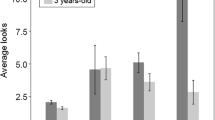Abstract
Visually attending to conspecifics can give group-living primates important ecological information, help them to anticipate the behavior of others and to regulate interactions with them, and provide other valuable social information. Variation in the importance and quality of social relationships should influence the way individuals selectively attend to fellow group members. Preliminary data on visual monitoring of conspecifics by wild female mountain gorillas (Gorilla gorilla beringei) show that selective attention mirrors variation in social relationships. Social bonds between males and females are central to gorilla society; correspondingly, females are more likely to stop feeding, and focus their attention on males who walk into view than on females, especially when males give dislays. Females are more likely to focus on other females with whom they have antagonistic relationships than those (mostly close relatives) with whom they have affiliative, cooperative ones. Further research on the context and consequences of visual monitoring could help to address questions about the regulation of social relationships and about social cognition in gorillas.
Similar content being viewed by others
References
Alberts, S. C. 1994. Vigilance in young baboons: effects of habitat, age, sex, and maternal rank on glance rate.Anim. Behav., 47: 749–755.
Altmann, S. A. 1967. The structure of primate social communication. In:Primate Social Communication,Altmann,S. A. (ed.), Univ. of Chicago Press, Chicago, pp. 325–362.
Byrne, R. B., 1995.The Thinking Ape, Oxford Univ. Press, Oxford
Byrne, R. B. in press. How monkeys find their way: leadership, coordination, and cognitive maps of African baboons. In:Group Movements in Social Primates: Patterns, Processes, and Cognitive Implications,Boinski S.; Garber, P (eds.), Cambridge Univ. Press, Cambridge.
Byrne, R. B.;Whiten, R. J. 1992. Computation and mindreading in primate tactical deception. In:Natural Theories of Mind,Whiten,A. (ed.), Blackwell, London, pp. 127–141.
Caine, N. E.;Marra, S. L. 1988. Vigilance and social organization in two species of primates.Anim. Behav., 36: 897–904.
Chance, M. R. A. 1967. Attention structure as the basis of primate rank, orders.Man, 2: 503–518.
Gomez, J. C. 1994. Mutual awareness in primate communication: a Gricean, approach. In:Self-Awareness in Animals and Humans,Parker,S. T.;Mitchell,R. W.;Boccia,M. L. (eds.), Cambridge Univ. Press, Cambridge, pp. 61–80.
Gomez, J. C. 1996. Ostensive behavior, in great apes: the role of eye contact. In:Reaching into Thought: The Minds of the Great Apes,Russon,A. E.;Bard,K. A.;Parker,S. T. (eds.), Cambridge Univ. Press, Cambridge, pp. 131–151.
Green, S.;Marler, P. 1979. The analysis of animal communication. In:Handbook of Neurobiology, Vol. 3: Social Behavior and Communication,Marler,P.;Vandenberg,J. (eds.) Plenum, New York, pp. 73–158.
Harcourt, A. H. 1979a. Social relationships among adult female mountain gorillas.Anim. Behav., 27: 251–264.
Harcourt, A. H. 1979b. Social relationships between adult male and adult female mountain gorillas.Anim. Behav., 28: 325–342.
Harcourt, A. H.;Stewart, K. J. 1996. Function and meaning of wild gorilla “close” calls 2: correlations with rank and relatedness.Behaviour, 133: 827–845.
Maestripieri, D.;Schino, G.;Aureli, F.;Troisi, A. 1992. A modest proposal: displacement as an indicator of emotions in primates.Anim. Behav., 44: 967–979.
Povinelli, D.; Eddy, T. 1996a. What young chimpanzees know about seeing.Monographs of the Society for Research in Child Development. 61 (Serial No. 247).
Povinelli, D.;Eddy, T. 1996b. Factors influencing young chimpanzees' (Pan troglodytes) recognition of attention.J. Comp. Psychol., 110: 336–345.
Schaller, G. 1963.The Mountain, Gorilla. Univ. of Chicago Press, Chicago.
Smuts, B. B. 1985.Sex and Friendship in Baboons, Aldine, Chicago.
Stewart, K. J.;Harcourt, A. H. 1987. Gorillas: variation in female relationships. In:Primate Societies,Smuts,B. B.;Cheney,D. L.;Seyfarth,R. M.;Wrangham,R. W.;Struhsaker,T. T. (eds.), Univ. of Chicago Press, Chicago, pp. 155–164.
Stewart, K. J.;Harcourt, A. H. 1994. Gorillas' vocalizations during rest periods: signs of inpending departure?.Behaviour, 130: 29–40.
Strayer, F. F.;Gariepi, J. L. 1986. The structure of social attention and its coordination with cohesive and dispersive activities in captive groups of squirrel monkeys. In:Current Perspectives in Primate Social Dynamics,Taub,D. M.;King,F. A. (eds.), (Van Nostrand Rheinhold, New York, pp. 99–110.
Tanner, D.;Byrne, R. W., 1996. Representation of action through iconic gesture in a captive lowland gorilla.Curr. Anthropol., 37: 162–173.
van Schaik, C. P.;van Noordwijk, M. A.;Warsono, B.;Sutriono, E. 1983. Party size and early detection of predators in Sumatran forest primates.Primates, 24: 211–221.
Watts, D. P. 1988. Environmental influences on mountain gorilla time budgets.Amer. J. Primatol., 15: 295–312.
Watts, D. P. 1992. Social relationships of resident and immigrant female mountain gorillas: I. Malefemale relationships.Amer. J. Primatol., 28: 159–181.
Watts, D. P. 1994a. Social relationship of resident and immigrant female mountain gorillas: II. Relatedness, residence, and relationships between females.Amer. J. Primatol. 32: 13–30.
Watts, D. P. 1994b. Agonistic relationships of female mountain gorillas.Behav. Ecol. Sociobiol. 34: 347–358.
Watts, D. P. 1995. Post-conflict social events in wild gorillas: 1. Social interactions between opponents.Ethology, 100: 158–174.
Watts, D. P. 1996. Comparative socioecology of gorillas. In:Great Ape Societies,McGrew,W. C.;Marchant,L. M.;Nishida,T. (eds.), Cambridge Univ. Press, Cambridge, pp. 16–28.
Watts, D. P. 1997. Agonistic interventions in wild mountain gorilla groups.Behaviour, 134: 23–57.
Watts, D. P. in press. Mountain gorilla habitat use strategies and group movement. In:Group Movements in Social Primates: Patterns, Processes, and Cognitive, Implications.Boinski S.; Garber, P. (eds.), Cambridge Univ. Press, Cambridge.
Author information
Authors and Affiliations
About this article
Cite this article
Watts, D.P. A preliminary study of selective visual attention in female mountain gorillas (Gorilla gorilla beringei). Primates 39, 71–78 (1998). https://doi.org/10.1007/BF02557744
Received:
Accepted:
Issue Date:
DOI: https://doi.org/10.1007/BF02557744




